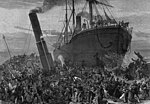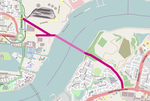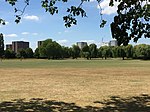Thames Gateway Water Treatment Works
BecktonDesalination plants in the United KingdomThames WaterUse British English from August 2022Water supply and sanitation in England and Wales
The Thames Gateway Water Treatment Works or Beckton Desalination Plant is a desalination plant in Beckton, London, adjacent to Beckton Sewage Treatment Works. The plant takes brackish water from the River Thames and converts it into drinkable water through a reverse osmosis process. The first of its kind in the UK, it was built for Thames Water by a consortium of Interserve, Atkins Water and Acciona Agua. It was opened by Prince Philip, Duke of Edinburgh, on 2 June 2010. It was planned to provide up to 150 million litres of drinking water each day – enough for 900,000 Londoners.
Excerpt from the Wikipedia article Thames Gateway Water Treatment Works (License: CC BY-SA 3.0, Authors).Thames Gateway Water Treatment Works
Stone Walk, London Barking Riverside (London Borough of Barking and Dagenham)
Geographical coordinates (GPS) Address External links Nearby Places Show on map
Geographical coordinates (GPS)
| Latitude | Longitude |
|---|---|
| N 51.51554 ° | E 0.09278 ° |
Address
Thames Gateway Water Treatment Works (Beckton Desalination Plant)
Stone Walk
IG11 0JU London, Barking Riverside (London Borough of Barking and Dagenham)
England, United Kingdom
Open on Google Maps










